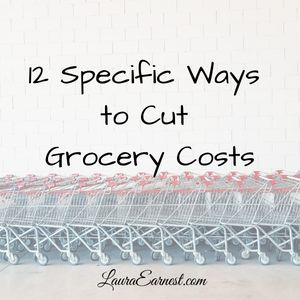
12 Specific Ways to Cut Grocery Costs
With inflation rising, our money doesn’t go as far as it used to. Everyone I know is looking for ways to cut back expenses. Here are 12 ways I use to cut grocery costs.
- Buy produce in season. Seasonal fruits and veggies will be cheaper than out of season. It’s the law of supply and demand applied to the grocery! Local food is often less expensive than produce shipped in from across the country. If you have a garden, your produce is guaranteed to be in season and locally produced. If you don’t have a garden, check out local farmer’s markets and pick-your-own farms.
- Buy other items in sale season. Seasonal items are not just fresh foods, though. Pumpkin and turkeys go on sale in November. Baking supplies in December. Hams in spring. Know when you can get the best deals and stock up on non-perishables or things that cam be frozen.
- Stretch your meat with fillers. Many meat dishes can be stretched with various fillers. I love to include mashed black beans with hamburger – it gives added fiber and doesn’t set the taste off too much, especially if I season well.
- Stretch meat by using less. Most dishes where meat is combined with something else can often have the quantity of meat reduced without noticeable differences. For example, instead of using a full pound of chicken breasts in a stir fry, I use about 1/3 of a pound and use lots of veggies.
- Slow cook or pressure cook cheaper cuts. Tough meat is cheap. By cooking meat in a slow cooker all day, or sending it through a pressure cooker, you will have a dish that falls apart with a fork. I use tougher cuts of roast in the crock and add barbecue sauce for a great and easy meal.
- Make freezer soup. In my house, no one ever finishes the veggies. Plus I have a terrible time remembering to use fresh produce in the fridge. My solution is to keep a couple of containers in the freezer. I put in the last spoonful of vegetables after dinners. I also dice up any tired produce at the end of the week. When I have a few containers, I get out my stock pot, add chicken stock, the veggies and cook away. It’s a delicious soup.
- Avoid loss leaders. Loss leaders are those unbelievable deals that grocery stores use to get you in the stores. They can also be found at the ends of aisles. Beware, though. These are not always the best deal for that type of item, and if you don’t need or use what you are buying it is wasted money.
- Make a list and stick to it. Impulse spending can add a lot of money to a grocery bill. I noticed that when I pick up my groceries after having someone pull the order, I save about $30 every two weeks.
- Scan the ads. By knowing what is on sale, you can add items you commonly use to your list. Recently my grocery store had whole chickens on sale for 22 cents a pound! I stocked up on them and froze the excess without breaking the list.
- Cook from scratch. For many items, cooking from scratch is much cheaper. Using spices and some chicken bouillon granules, I can have seasoned noodles for a fraction of what it would cost to buy the packaged mix. Homemade cookies are also less expensive than the bakery ones. A big batch of waffles stashed in the freezer cost way less than the commercial versions.
- Know your stores. Some stores are consistently less than others. I can get spices in bulk at my warehouse club at prices the grocery can’t touch. Weekly items like milk, eggs, standard cuts of meat and bread I get at the local Lidl (like Aldi). Don’t fall into the trap of thinking that Dollar Stores are automatically better prices – many of their food items are smaller packages or fewer servings. Rice is far cheaper in bulk at the Asian grocery down the street.
- Get help. Frugal shopping is easy when someone prepares the menus and shopping lists and hands them to you. There are many recipe sites out there that can help with this.
Cutting grocery costs isn’t hard when you have a place to start. Does anyone have any other tips to share?




